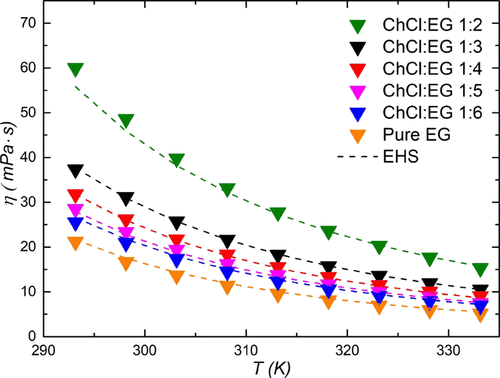当前位置:
X-MOL 学术
›
J. Chem. Eng. Data
›
论文详情
Our official English website, www.x-mol.net, welcomes your feedback! (Note: you will need to create a separate account there.)
Viscosity of Choline Chloride-Based Deep Eutectic Solvents: Experiments and Modeling
Journal of Chemical & Engineering Data ( IF 2.6 ) Pub Date : 2020-10-13 , DOI: 10.1021/acs.jced.0c00715 Nicolás F. Gajardo-Parra 1 , Vincenzo P. Cotroneo-Figueroa 1 , Paulo Aravena 1 , Velisa Vesovic 2 , Roberto I. Canales 1
Journal of Chemical & Engineering Data ( IF 2.6 ) Pub Date : 2020-10-13 , DOI: 10.1021/acs.jced.0c00715 Nicolás F. Gajardo-Parra 1 , Vincenzo P. Cotroneo-Figueroa 1 , Paulo Aravena 1 , Velisa Vesovic 2 , Roberto I. Canales 1
Affiliation

|
Deep eutectic solvents (DESs) have emerged as promising “green” solvents, but their successful industrial application requires relatively low viscosity. DESs prepared from choline chloride and glycols offer such a possibility. Viscosity and density are reported for a number of DESs obtained by mixing choline chloride and a glycol (ethylene glycol, 1,2-propanediol, 1,3-propanediol, and 1,4-butanediol). The measurements were performed at 101.3 kPa, at temperatures between 293.15 and 333.15 K, and for different mole ratios of glycol and choline chloride. The viscosity was measured with a capillary viscometer, while the density was measured by means of a vibrating U-tube densimeter. The density and viscosity data have expanded relative uncertainties of 0.2 and 2.0%, respectively, with a coverage factor of 2. The viscosity of pure glycols was modeled using the extended hard-sphere (EHS) model that has its basis in kinetic theory and the molecular description of the fluid. Each DES was treated as a binary mixture, and the EHS model was used, with a mole average mixing rule, to calculate its viscosity. The measured DES viscosity data were represented with an average absolute deviation of 1.4% and a maximum deviation of 7%.
中文翻译:

基于胆碱氯化物的深共晶溶剂的粘度:实验和建模
深低共熔溶剂(DES)已成为有前途的“绿色”溶剂,但其成功的工业应用需要相对较低的粘度。由氯化胆碱和乙二醇制备的DES提供了这种可能性。报告了通过混合氯化胆碱和乙二醇(乙二醇,1,2-丙二醇,1,3-丙二醇和1,4-丁二醇)获得的许多DES的粘度和密度。测量在101.3 kPa,293.15和333.15 K之间的温度下进行,并且乙二醇和氯化胆碱的摩尔比不同。用毛细管粘度计测量粘度,而用振动U型管密度计测量密度。密度和粘度数据的相对不确定度分别为0.2和2.0%,覆盖因子为2。使用扩展硬球(EHS)模型对纯二醇的粘度进行建模,该模型在动力学理论和流体的分子描述方面具有基础。每个DES被视为二元混合物,并使用EHS模型(具有摩尔平均混合规则)来计算其粘度。测得的DES粘度数据的平均绝对偏差为1.4%,最大偏差为7%。
更新日期:2020-11-12
中文翻译:

基于胆碱氯化物的深共晶溶剂的粘度:实验和建模
深低共熔溶剂(DES)已成为有前途的“绿色”溶剂,但其成功的工业应用需要相对较低的粘度。由氯化胆碱和乙二醇制备的DES提供了这种可能性。报告了通过混合氯化胆碱和乙二醇(乙二醇,1,2-丙二醇,1,3-丙二醇和1,4-丁二醇)获得的许多DES的粘度和密度。测量在101.3 kPa,293.15和333.15 K之间的温度下进行,并且乙二醇和氯化胆碱的摩尔比不同。用毛细管粘度计测量粘度,而用振动U型管密度计测量密度。密度和粘度数据的相对不确定度分别为0.2和2.0%,覆盖因子为2。使用扩展硬球(EHS)模型对纯二醇的粘度进行建模,该模型在动力学理论和流体的分子描述方面具有基础。每个DES被视为二元混合物,并使用EHS模型(具有摩尔平均混合规则)来计算其粘度。测得的DES粘度数据的平均绝对偏差为1.4%,最大偏差为7%。



























 京公网安备 11010802027423号
京公网安备 11010802027423号